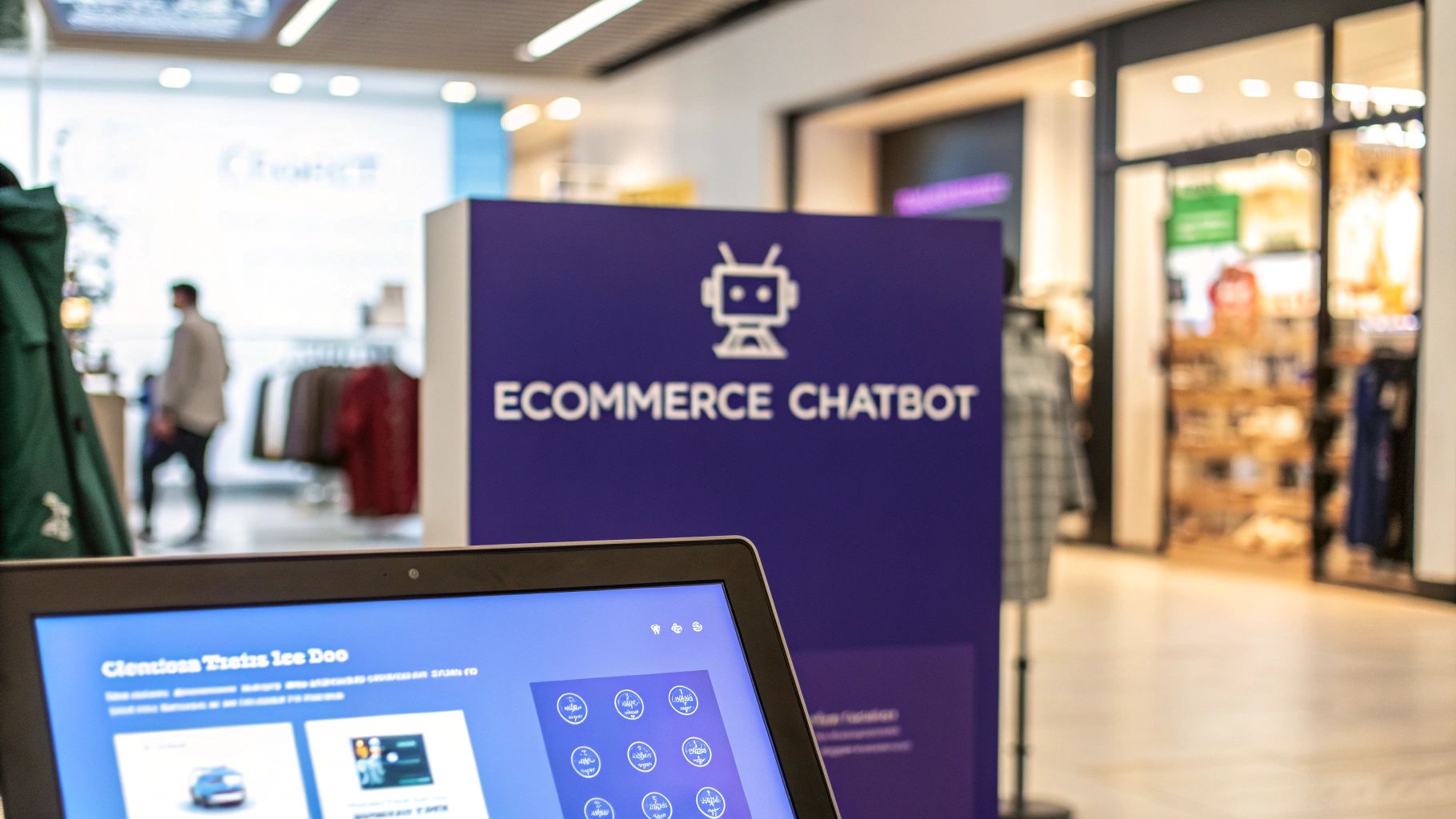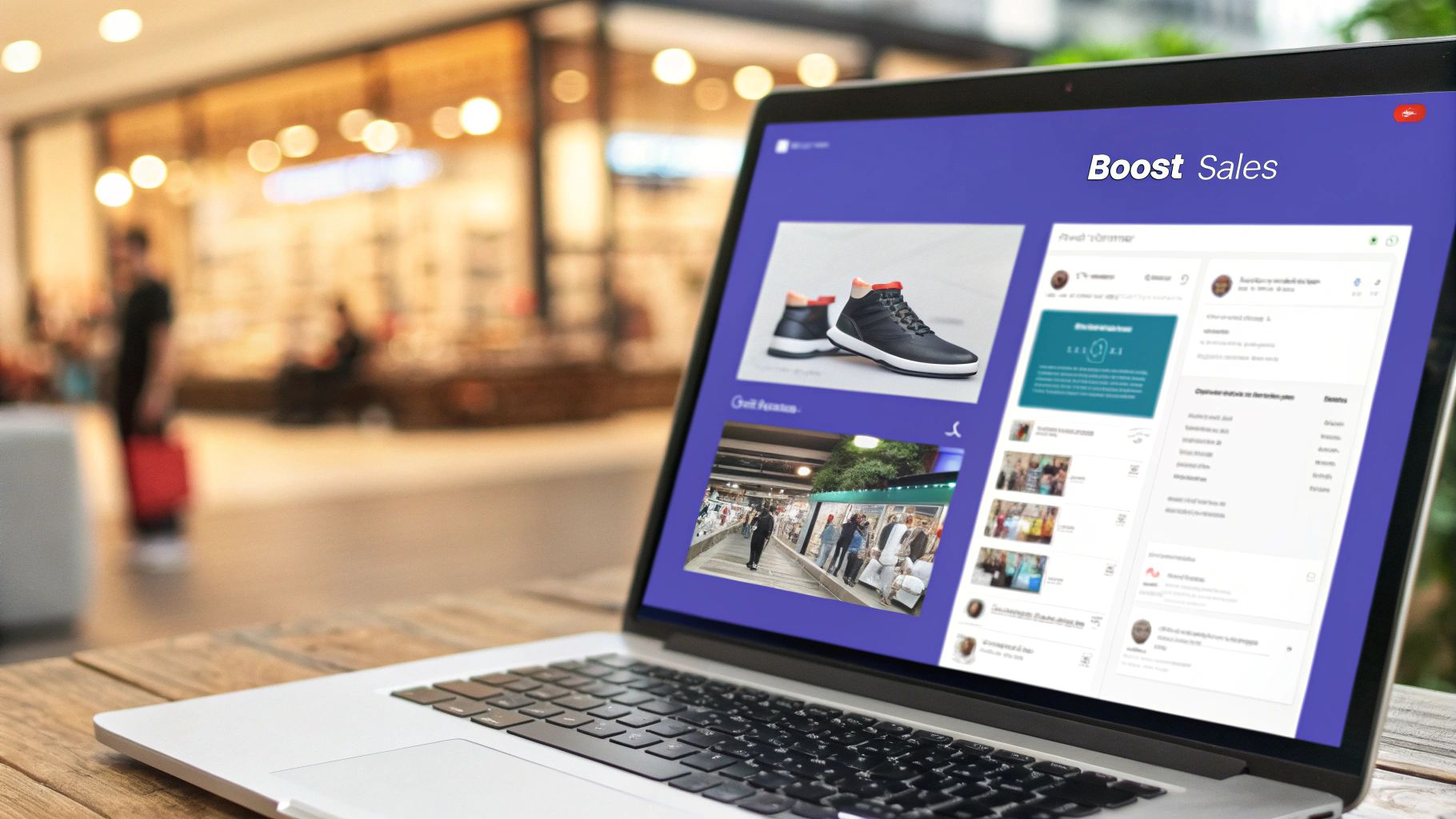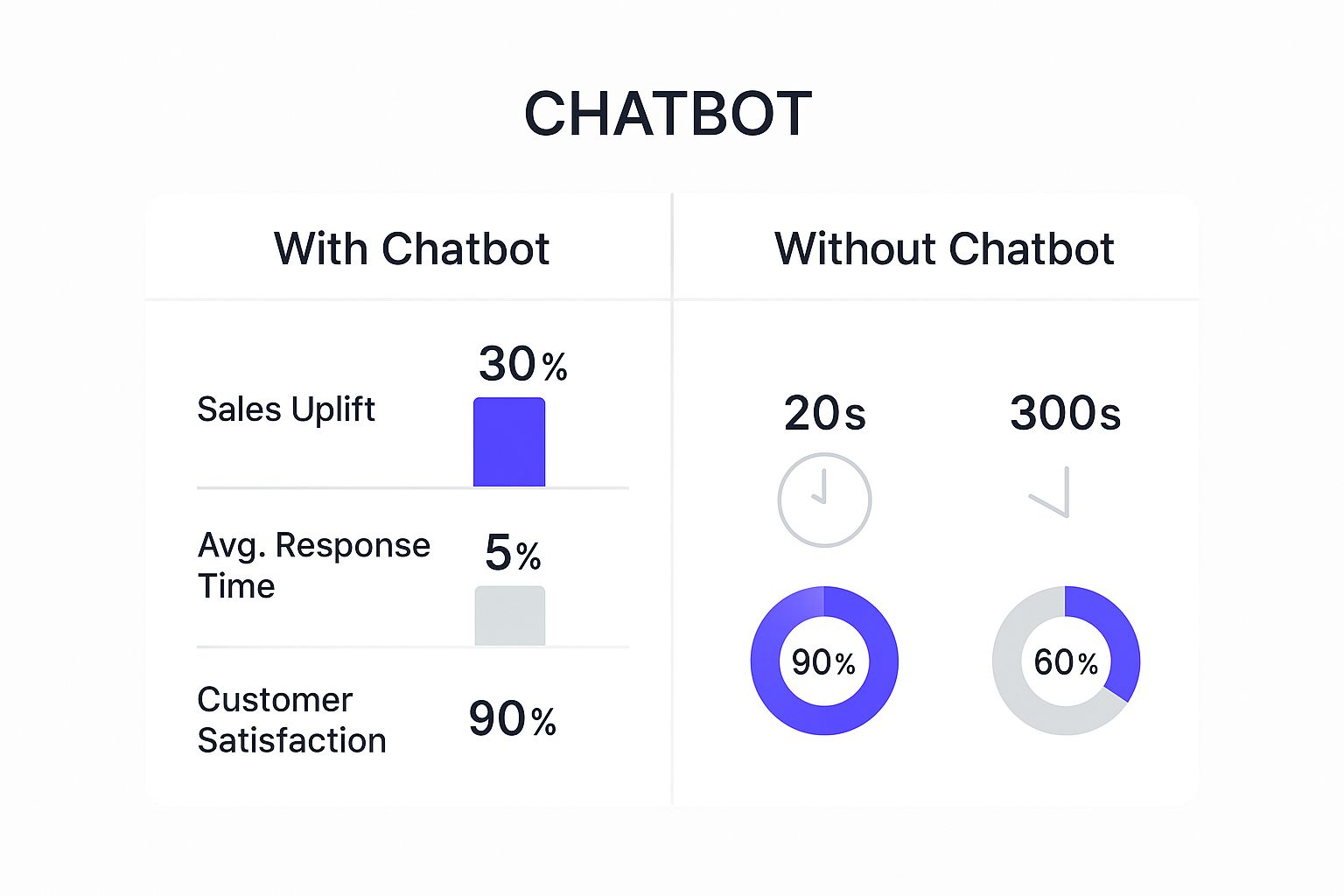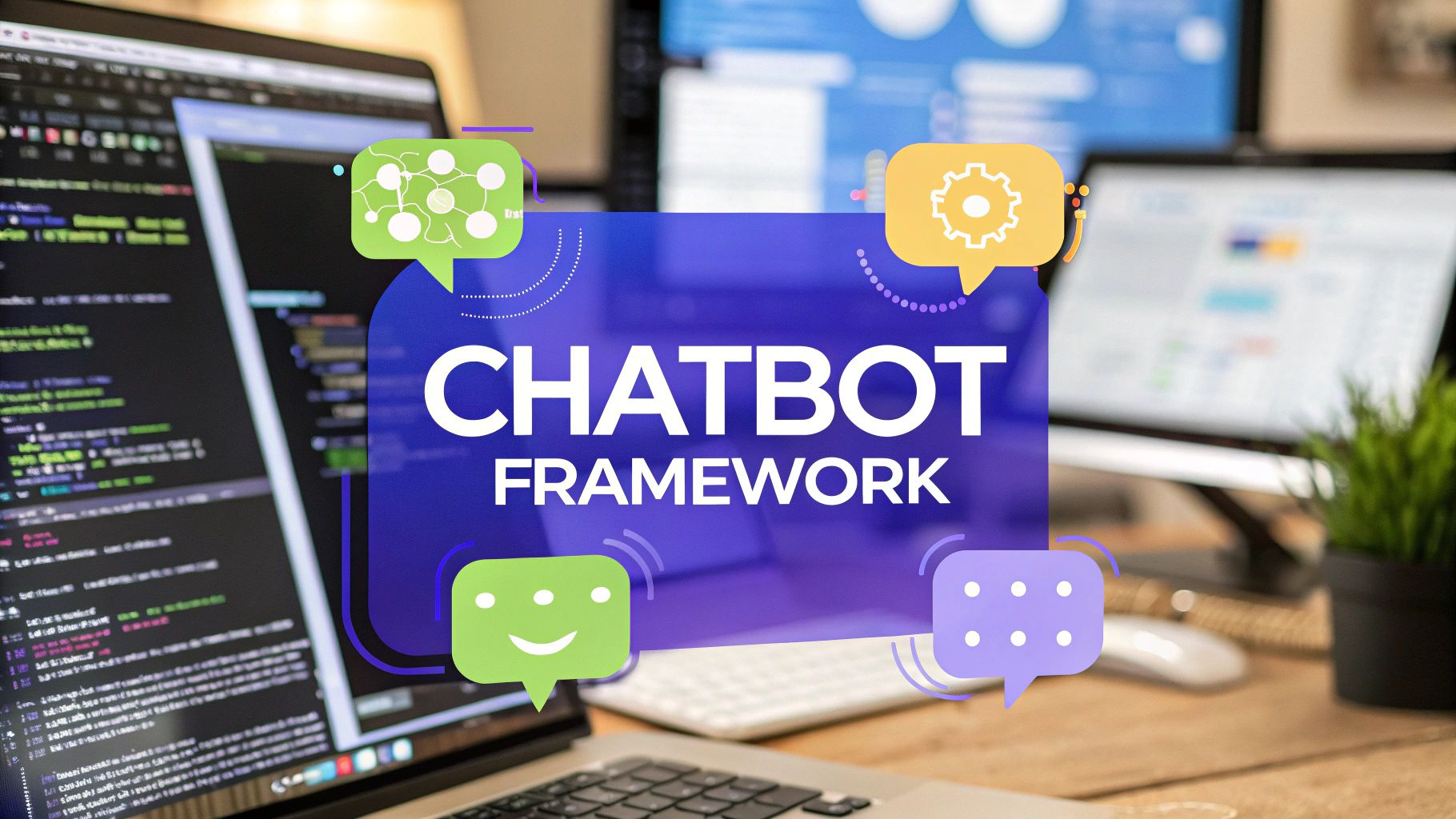Ultimate Guide to Chatbot in Ecommerce: Boost Your Sales
Learn how a chatbot in ecommerce can enhance customer experience, increase sales, and streamline your online store. Discover expert tips now!

Picture a tireless digital sales assistant, working 24/7 on your online store. That's the real power of an ecommerce chatbot. These AI-powered tools act as proactive members of your team, providing instant support and guiding shoppers from discovery all the way to checkout.
What Is an Ecommerce Chatbot, Really?
Think of an ecommerce chatbot as more than just a pop-up window. It’s a sophisticated program designed to simulate a real conversation, helping customers with a huge range of tasks right on your website. They serve as virtual agents, ready to answer questions and help shoppers at any moment.
https://www.youtube.com/embed/SWP3k-24jT4
This technology has come a long way from the simple, rule-based systems of the past. Early chatbots were like automated phone menus—stiff and limited to just a few preset responses. They could only handle basic stuff, like giving you the store’s hours or linking to a returns policy.
The Evolution Into Conversational AI
Modern AI-powered chatbots are a different beast entirely. They use advanced tech like natural language processing (NLP) to understand what customers are actually saying, even if it’s full of slang or typos. This allows for genuine, back-and-forth conversations that feel natural and genuinely helpful.
Instead of just following a rigid script, today’s chatbots can:
- Understand Intent: They dig into a customer’s message to grasp the real need behind the words.
- Generate Unique Responses: They craft answers in real time, creating a personalized experience for every single user.
- Learn and Adapt: Each interaction helps the chatbot get smarter, making its future conversations even more effective.
The market for this tech shows just how important it's become. Valued at $5.4 billion in 2023, the global chatbot market is expected to hit $15.5 billion by 2028, a jump fueled almost entirely by these AI advancements. You can see more of these ecommerce AI chatbot trends to get a feel for how fast the industry is moving.
A modern chatbot in ecommerce isn't just a reactive tool for FAQs. It's a proactive guide that can help with product discovery, manage orders, and even offer personalized discounts to drive sales.
These core functions are what transform a simple chat window into an indispensable part of your business operations.
Chatbot Core Functions in Ecommerce
Here’s a breakdown of the primary roles an ecommerce chatbot fills, supporting both your business goals and your customers.
Ultimately, these tools are no longer just for support. They've become essential for any online retailer focused on creating a standout customer experience and boosting the bottom line. By understanding what your customers truly want, a chatbot acts as a personal shopper, sales associate, and support agent all in one, completely changing how people interact with your brand online.
The Real-World Benefits of an Ecommerce Chatbot
Beyond just being a slick feature, an ecommerce chatbot brings some serious, real-world advantages that directly fatten your bottom line. These benefits go way beyond just offering "better support." We're talking about measurable growth, starting with major savings on your day-to-day operations.

Think about all the repetitive questions your team answers every single day. "Where is my order?" or "What's your return policy?" Automating these frees up your human agents to focus on high-value conversations—like helping a customer navigate a complex purchase or resolving a sensitive issue that needs a human touch.
Drive Growth Around the Clock
One of the biggest wins here is 24/7 availability. Online shopping doesn't punch a clock, and neither should your customer service. A chatbot ensures that a customer browsing your site at 3 AM on a Sunday gets an instant, helpful answer instead of an auto-reply telling them you'll get back to them later.
That instant gratification is everything. It meets modern expectations, boosts satisfaction, and helps build the kind of long-term loyalty that turns one-time buyers into lifelong fans. It’s like having your best salesperson on the floor, ready to help at a moment's notice.
This constant presence also turns your website into a lead generation engine that never sleeps. Every single interaction is a chance to:
- Capture Visitor Information: Ask for an email in exchange for a discount or a back-in-stock notification.
- Qualify Potential Leads: Figure out what a visitor needs and point them to the right product or sales rep.
- Gather Valuable Insights: Collect data on common questions and pain points to make your marketing and products even better.
The explosive growth of the market really tells the story. By 2025, the global chatbot market expanded to roughly $15.57 billion, a massive jump from just $2.47 billion in 2021. This surge is all about their power to automate service, with businesses on track to save up to $11 billion and 2.5 billion work hours every year.
Increase Sales and Reduce Friction
A chatbot isn't just a defensive tool for your support team; it’s a proactive sales driver. By jumping in at just the right moment, it can give your revenue a serious lift and make the whole shopping experience smoother.
For example, you can set up a chatbot to pop up when someone has been lingering on a product page, offering to answer questions or provide a sizing guide. That small, timely nudge can be exactly what a hesitant shopper needs to finally add an item to their cart.
If you're curious, you can check out our deep dive into using chatbots for ecommerce to see these strategies in action. By cutting out friction and providing instant clarity, chatbots directly lead to higher conversion rates and a much healthier bottom line.
Alright, let's move past the theory and talk about what really matters: how chatbots actually make you money. These aren't just glorified FAQ pages; a well-built chatbot is one of the most effective sales reps you can have on your team. It's an active assistant, designed to guide shoppers from "just browsing" to "just bought."

Think about it. A visitor is clicking back and forth between two different product colors, clearly stuck. Instead of just letting them get frustrated and leave, a chatbot can pop up with a simple, "Having trouble deciding? I can help you find the perfect fit!"
That single, well-timed message can be the difference between a lost visitor and a new customer. By stepping in at the exact moment of hesitation, the chatbot keeps the shopper engaged and moving toward the checkout.
Act as a Personal Product Guide
One of the most powerful things a chatbot can do is act as a personal shopper. We've all been there: you land on a site, get overwhelmed by hundreds of options, and have no idea where to start. This is where a guided conversation can completely change the game.
For instance, a chatbot for an outdoor gear store could kick things off by asking:
- "What kind of activity are you planning? Hiking, camping, or climbing?"
- "What's the weather like where you'll be?"
- "Are you looking for something lightweight for long distances?"
Based on these answers, the chatbot instantly sifts through your entire product catalog and presents a handful of perfect recommendations. This gets rid of the friction of endless scrolling and feels just like getting advice from a helpful, knowledgeable store employee. It makes customers feel understood and gives them the confidence to buy.
By proactively guiding uncertain shoppers, a chatbot can dramatically reduce bounce rates. It transforms a potentially frustrating search into a helpful, conversational experience that directly leads to a sale.
Recover Abandoned Carts and Offer Timely Deals
Every online store owner knows the pain of cart abandonment. It’s a huge challenge, but a chatbot gives you a powerful way to fight back. When a shopper with items in their cart moves to exit the page, the chatbot can jump in with a targeted message.
It might say something like, "Hold on! Did you forget something? Here’s a 10% discount to help you complete your order today." That friendly nudge, paired with a real incentive, is surprisingly effective at clawing back what would have been a lost sale.
But it doesn't stop there. These bots can also deliver personalized promotions in real-time. If a customer has bought running shoes from you before, the chatbot can greet them on their next visit with a special offer on new athletic socks. These specific, relevant deals make the shopping experience feel personal, which is key to encouraging repeat business and building real customer loyalty. A good chatbot doesn't just answer questions; it actively creates sales.
Choosing and Integrating the Right Chatbot
Picking the perfect chatbot for your store isn't about grabbing the flashiest tool off the shelf. Think of it like hiring a new team member. You need to be sure they’ll work well with your existing setup and have the right skills to grow with your business.
The first thing to check is compatibility. Does the chatbot platform play nicely with your ecommerce backbone, like Shopify or WooCommerce? A smooth integration means the bot can see your product catalog and inventory in real-time, which stops it from recommending out-of-stock items—a surefire way to kill a sale.
Key Criteria for Your Selection
When you're weighing your options, zero in on a few critical areas. First, how smart is the AI? A simple rule-based bot can handle basic FAQs, but an AI-powered one can actually understand what customers mean, untangle complex questions, and deliver the kind of personalized experiences that drive sales.
Next up is scalability. Your business is going to grow, and your chatbot needs to keep up. Can it handle a surge in traffic during Black Friday without breaking a sweat? A scalable solution means your investment keeps paying dividends as your store expands.
Before you commit, it's wise to compare platforms on a few essential features. Some bots are pretty basic, while others are packed with sophisticated AI.
Chatbot Platform Feature Comparison
When evaluating different chatbot solutions for your ecommerce store, consider how they stack up on these essential features.
Ultimately, the goal is to find a tool that not only fits your current needs but also has the power to adapt as you grow. The right choice makes a real, measurable difference.
Just look at the numbers—they speak for themselves.

As you can see, a well-implemented chatbot can slash response times while giving both your sales and customer satisfaction a serious boost.
Your Integration Roadmap
Once you've made your choice, it's time for integration. The key here is to take a phased approach. Don't try to automate everything at once, or you risk creating a clunky experience for your customers.
Start with a clear, focused goal. For example, begin by training the chatbot to handle your top 3-5 most frequent customer questions, like "Where is my order?" or "What is your return policy?" Nailing these high-volume queries first delivers an immediate impact.
From there, you can start designing your first conversation flows. Map out how the chatbot will greet visitors, guide them through common issues, and—most importantly—when and how it should hand things over to a human agent. For a more detailed walkthrough, you can learn more about how to add a chatbot to your website with our step-by-step guide.
Finally, you'll train the AI on your brand’s unique voice and product details. This is what separates a generic, forgettable bot from one that feels like a genuine part of your team. By starting small and expanding its role over time, you’ll build a powerful asset that makes the entire customer journey better.
Best Practices for Chatbot Success
Getting a chatbot live is just the first step. The real magic happens when you optimize it—turning it from a basic tool into an asset customers actually like using. If you want to build an ecommerce chatbot that genuinely improves the customer experience, you'll need to focus on a few key areas that go far beyond the initial setup.
Think of this as your checklist for deploying a bot that truly delivers.

First things first: give your chatbot a personality. It can't sound like a generic, faceless robot. Instead, its tone should mirror your brand's identity. Is your brand fun and a bit quirky? Professional and reassuring? Whatever it is, your bot should reflect that. This makes every interaction feel more authentic and less transactional.
Just like hiring a new team member, you'd want them to represent your company culture well. Your chatbot is no different. A consistent voice builds trust and makes the entire experience more memorable for your customers.
Design a Flawless Human Handover
Let's be realistic: no chatbot can answer everything. Knowing when to pass a conversation to a human agent is critical, and a clunky handover is one of the fastest ways to frustrate a customer. The goal here is to make this transition so smooth, the customer barely notices.
Before the transfer, the chatbot should gather all the essential details—name, order number, and a quick summary of the issue. That way, the customer doesn't have to repeat a single thing. Your support agent can jump right in with all the context they need, turning a potential friction point into a surprisingly positive interaction.
Be transparent from the start. Let users know they're talking to an AI. Setting clear expectations right away prevents confusion and helps build trust, making customers more patient if the bot hits a limitation.
Improving your chatbot isn't a one-and-done task; it's an ongoing process. To do it right, you have to dig into the data and see how your bot is actually performing in the wild.
- Analyze Chat Logs: Regularly comb through conversation transcripts. Look for common questions where the bot stumbles or where users frequently drop off. These are goldmines for identifying clear opportunities for improvement.
- Gather Customer Feedback: A simple post-chat survey can work wonders. Just ask, "Was this helpful?" The feedback you get is invaluable for fine-tuning conversational flows and responses.
- Refine and Retrain: Use all that data to update your chatbot's knowledge base and tweak its scripts. This iterative cycle is what ensures your bot gets smarter and more effective over time.
By putting these strategies into practice, you'll build a system that doesn't just assist customers but also learns and evolves with them. For a deeper dive, our guide on chatbot best practices offers more detailed strategies for turning your bot into a powerhouse. These steps will help ensure your chatbot is a valuable asset that drives both satisfaction and loyalty.
Here is the rewritten section, crafted to sound human-written and match the provided examples.
The Future of Conversational Commerce
If you think of ecommerce chatbots as those simple, clunky Q&A bots from a few years ago, it's time to look again. The future of conversational commerce is already here, and it’s a lot smarter and more dynamic than most people realize.
We're moving far beyond rigid, scripted interactions. The goal now is to create intelligent digital assistants that feel like a natural part of the shopping experience.
The Rise of Smarter Conversations
The biggest shift comes from generative AI, which lets chatbots hold conversations that actually sound human. Instead of just pulling answers from a list, they can now understand the flow of a conversation and generate unique, relevant responses on the fly.
This means a bot can do more than just recommend a product. It can explain why that specific product is a good fit based on what you've been discussing, just like a helpful store associate would.
This shift is happening alongside a few other key trends. Voice-powered shopping is on the rise, and hyper-personalization is becoming standard, with bots analyzing deep data to craft unique customer journeys. They’re also becoming the glue in omnichannel strategies, seamlessly connecting conversations from a social media DM all the way to your website chat.
These aren't just minor tweaks; the impact is huge. Modern AI chatbots now resolve roughly 70-80% of customer queries without any human help. It's no surprise that enterprises are seeing real revenue growth from these AI-driven interactions. In fact, by 2025, chatbots became the main support channel for about 40% of businesses. You can learn more about these AI chatbot stats and their impact.
For any forward-thinking ecommerce brand, investing in this kind of technology is no longer a "nice-to-have." It’s becoming a foundational part of staying competitive.
Of course. Here is the rewritten section, designed to sound like it was written by an experienced human expert, following all the provided guidelines and examples.
Common Questions About Ecommerce Chatbots
As you get closer to adding a chatbot to your online store, a few practical questions always seem to pop up. Let's tackle some of the most common ones I hear from ecommerce owners so you can understand what this really looks like in practice.
How Much Does an Ecommerce Chatbot Cost?
The cost really depends on how much heavy lifting you want the bot to do.
Simple, rule-based chatbots can get you started with free plans or for a pretty low cost, often around $50–$100 per month. But if you're looking for a smarter, AI-powered bot that integrates deeply with your inventory or CRM, you can expect to pay anywhere from a few hundred to several thousand dollars a month.
Will a Chatbot Hurt My SEO?
It’s a fair question, but a well-designed chatbot actually does the opposite—it can give your SEO a nice boost. Think about it: by engaging visitors the moment they land and answering their questions, your bot can:
- Slash your bounce rate by giving people a reason to stick around.
- Increase the average time people spend on your site.
Both of these are huge green flags for search engines like Google. A better user experience almost always translates into better search performance.
A chatbot keeps the user journey moving forward by offering instant value and support. That improved experience is exactly what search algorithms are designed to reward, making it a clear win for your SEO.
Can a Chatbot Handle Multiple Languages?
Absolutely. Most modern AI chatbot platforms are built with global business in mind and come with multilingual support. They can often detect a user's browser language automatically or let shoppers pick their preferred language from a menu.
This is a must-have for any store with international ambitions, as it ensures every customer gets the same clear, helpful experience.
Is It a Pain to Set Up a Chatbot?
The setup really depends on the platform you choose. A lot of modern chatbot builders have incredibly user-friendly, no-code interfaces that let you build and launch a basic bot in just a few hours.
Connecting it to your CRM or inventory system to unlock more powerful automations will take more technical work, but that’s where the real magic happens for personalization and efficiency.
Ready to see how an AI agent can change the game for your sales and support? Chatiant lets you build custom chatbots trained on your own data in minutes. You can integrate it seamlessly with your website and internal tools to deliver instant, personalized support. Create your first AI agent with Chatiant today.


